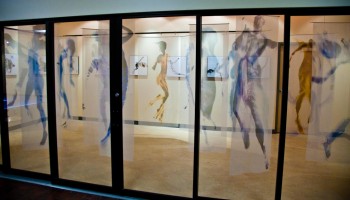 Mark Lewis’ fine-art photography almost demands a three-dimensional interpretation. And, in a community known worldwide as a Mecca for sculpture – Loveland, Colo. – Lewis has yearned to find a way to interpret his work in three dimensions.
Mark Lewis’ fine-art photography almost demands a three-dimensional interpretation. And, in a community known worldwide as a Mecca for sculpture – Loveland, Colo. – Lewis has yearned to find a way to interpret his work in three dimensions.
Inspired by the graphics used for the King Tut exhibit at the Denver Museum of Art, which used gauzy, translucent fabric banners as a focal point for the exhibit, Lewis formed a concept for his own exhibition. Lewis called his LexJet account specialist, Michael Clementi, to brainstorm about inkjet printable materials he could use to bring his concept to life. Clementi recommended Polyvoile FR fabric and Lewis began testing the material on his Epson Stylus Pro 9880.
“I started to think about all the 3D things I’ve been working on, and had the idea that if I had a 3D space, I could put up my 2D artwork on the wall, like a gallery presentation, and then hang my new abstract figures on these banners and suspend them throughout the room, leaving areas for people to walk through. The idea was to create one large piece of art comprised of individual pieces that combine into one large art object that can be walked into,” explains Lewis.
 Lewis secured space at Aims Community College in nearby Greeley, Colo., and set up the display, mixing framed photo prints on the walls with Polyvoile banners hung throughout the space. The banners are abstract representations of Lewis’ Zero G series of nude studies.
Lewis secured space at Aims Community College in nearby Greeley, Colo., and set up the display, mixing framed photo prints on the walls with Polyvoile banners hung throughout the space. The banners are abstract representations of Lewis’ Zero G series of nude studies.
Lewis explains, “The Zero G originals on the wall are a few years older and incorporate figure nudes with an illusion of weightlessness, so they look like they’re floating in air or water. The translucent Polyvoile banners that are 7 feet tall and 2-3 feet wide, are extreme abstract figures that almost look like they’re made out of lightning and movement. The photographic process is very different for the abstract pieces than it was for the Zero G process.
“The Zero G series is an illusion based on light,” Lewis continues. “The second, abstract version is the same concept with much longer exposures of 6-8 seconds. I’m using my studio strobe flash, but I’m manually firing it. I have either camera or model movement, and sometimes I’ll use materials like painter’s plastic or sheer cloth material and a fan. As the material and model are moving then I’m popping up these individual flashes, and in between the flashes I have a bright hot light on. It sinks in low light exposure in between the strobes, and then the strobes capture those individual seconds within the six seconds. I’m getting a choppy freeze-frame effect. You end up with a big, blurry photo that looks like you can’t use it for anything. I take it into Lightroom, look at the figures inside that mess, trim everything away that I don’t want, and it leaves a part of those exposures and then I add a color temperature to it. I call it an organic process, because it’s like a big shrub that needs to be trimmed.”
The summer exhibition at Aims Community College has been a big hit. It’s an unusual interpretation of creative art that makes people think about light, images and perception. The exhibition will run through September, then Lewis will install a similar one in Loveland.

“That was the first experimental presentation of what I’d seen in my mind for a long time. I got everything printed up with no problem and had seams put in for the pole pockets. Once it was installed, I was very satisfied with the outcome. It was my first attempt to get dimension in photography that I felt was very successful,” says Lewis. “One of the questions that comes up a lot when people see it is how difficult it is to print. I never had a misprint with the material and it has worked perfectly every time. It was quite simple to print. I just followed the directions given to me by LexJet. I had to change pixel density to 720 and some minor adjustments like that, but I’ve printed in black and white and full color and have been pleased with every print I’ve made with it.”
Here’s a video of the exhibition…

